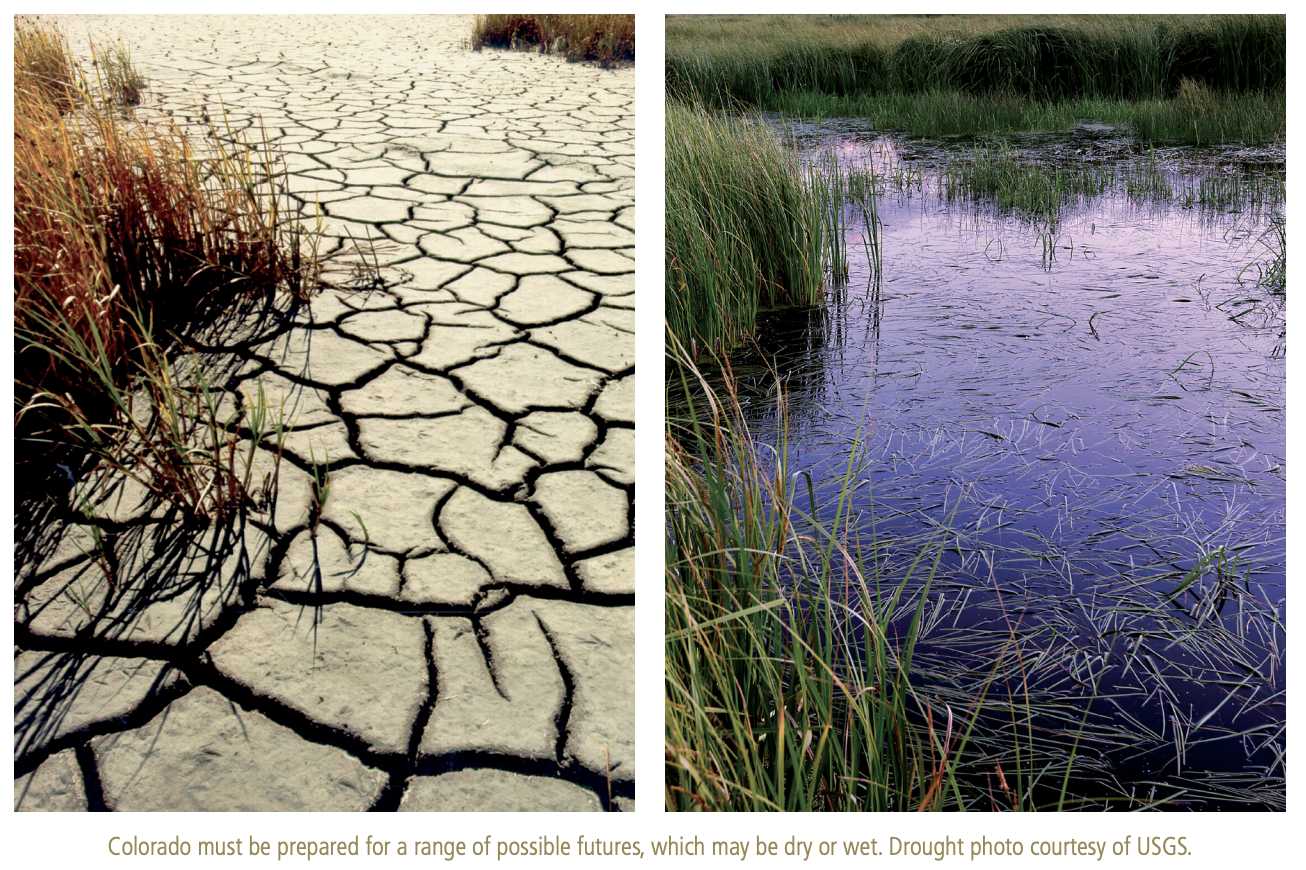
In June 2020, Colorado Governor Jared Polis activated the “State Drought Mitigation and Response Plan” developed by a state drought task force. While the plan’s goal is to address short-term issues, the Colorado Water Plan adopted by the state five years earlier has long-term goals.
The Water Plan is the state’s most comprehensive planning document for water management. The Colorado Water Conservation Board (CWCB) is the state agency overseeing the plan’s implementation, and is now working to update the underlying technical data in the plan. The update is set to be completed in 2022.
“We are gathering input, looking at all the numbers again, and making multiple revisions with the hope of doing public outreach in the latter half of 2021 and early 2022,” said Kevin Reidy, CWCB’s Water Conservation Specialist.
During the creation of the first version of the Water Plan, the board received 30,000 public comments, which was quite daunting to manage. The state legislature, local governments, and stakeholders from businesses and nonprofits were all invited to contribute to the plan’s creation.
To organize public comments on the plan update, the CWCB is using a new platform: EngageCWCB.org. The website also helps people understand the document, process and issues.
As a conservation specialist, Reidy’s work is focused on land use planning and water efficiency, especially in urban areas. When asked about what the green industry should know about the state’s Water Plan, he points to Section 6.1 Scenario Planning and Developing an Adaptive Water Strategy, Section 6.2 Meeting Colorado’s Water Gaps, and Section 6.3 Water Conservation and Reuse.
“Of interest to the horticulture industry, the plan discusses using water more efficiently, especially with water reuse and graywater use. That type of water use has different water chemistry, so that may drive the industry to develop more plants that withstand salts better,” he explained.
 The goal of the plan is to manage and plan water supplies in a holistic manner, taking into account impacts from climate change including droughts and wildfires.
The goal of the plan is to manage and plan water supplies in a holistic manner, taking into account impacts from climate change including droughts and wildfires.
“Our situation has changed dramatically. How do we develop policies and codes to withstand challenges like higher temperatures, changing seasonal precipitation, and shifting growing seasons, to be more resilient down the road?” he asked.
Responding to a Drier Climate
He hypothesized that trees and the plant palette grown in Colorado may have to look different in 20 to 30 years. Since the 2002 drought, he has already seen landscapes shift away from traditional plants with high-water needs.
He bemoans when some people accuse him of wanting to kill all of the trees. He likes trees! He just thinks they may have to look different in 20 years, compared to what we see today.
“The climate is changing. We will have to be more efficient with outdoor water – that’s just a fact. How do you adapt your business to the new reality? You may have to embrace different, newer ideas to stay ahead of the curve as a business and industry. You may not have as much control over it, so having flexibility will be helpful. A lot of opportunities are out there if we think about how to address efficiency,” he explained.
The Water Conservation Board is a planning and policy agency, not a regulatory agency, but other governments may use the Water Plan to make laws about water efficiency. Focusing on incentives and education rather than punitive measures would be a more supportive model for law making, he noted.
 “It’s not just about not using water. We want to have healthy landscapes, because that helps everybody down the road,” he added. “We can still use water. It’s just got to be in an efficient way: the right water for the right purpose, like more vegetable gardens, for instance. It’s really important not to restrict everything but to figure out better ways to do it and use water in more efficient ways, to weather these changes a little better,” he explained.
“It’s not just about not using water. We want to have healthy landscapes, because that helps everybody down the road,” he added. “We can still use water. It’s just got to be in an efficient way: the right water for the right purpose, like more vegetable gardens, for instance. It’s really important not to restrict everything but to figure out better ways to do it and use water in more efficient ways, to weather these changes a little better,” he explained.
Homebuilders focus on creating landscapes desired by the market and customers. Still, policymakers and the green industry could help direct what is put in the landscapes. Already in Colorado, xeriscape has increased, especially in commercial areas. On the other hand, graywater use has not been promoted as much as it could be for irrigation, though it has been legalized.
Funding Water Efficiency Projects
The state legislature has appropriated $30.5 million a year since 2017, to fund implementation of the Water Plan. Most of that funding is distributed through grants to a wide range of entities for projects with actions and objectives that align with the plan. The grant application periods changed in 2020, from two application deadlines a year to one on Dec. 1.
When asked if the horticulture industry could help advocate for continued funding for the Water Plan, Reidy said, “Advocacy helps us, but the legislature really does appreciate and has been supportive of the Water Plan and related programs. In 2021, COVID-19 may have an impact on the budget, so it will come down to whether or not there’s money.”
Of the annual amount, about $1 million has been available each year for land use, water reuse, and efficiency projects, including multiple-year projects. CWCB’s Water Conservation office has awarded $4.75 million in 27 grants since 2017, to various organizations, from government offices to utilities, nonprofits, and businesses.
One grantee was a small software developer that created a web portal for the real estate industry to connect new and prospective homeowners to water information, such as water rates, utilities, water sources, and conservation. Another software developer received a grant for developing a product to help land use planners and water use planners to talk together. Another grantee created a web portal where water customers can access real-time data from their water meters to better understand how to use water more efficiently.
The City of Aspen and South Metro Water Authority received grants to develop curriculum for adopting the Qualified Water Efficient Landscaper program to Colorado. Fort Collins Utilities used a grant to help homeowners associations fund planning and supplies for conversions to more water-efficient landscapes. Colorado Springs Utilities used grant funding toward a xeriscape education program for new homeowners that provided them with gift certificates for plants at local garden centers.
“For me, the goal with this funding is not just to change out equipment; the project or program needs to have some kind of value in educating and generating ideas,” he said.
Getting Involved
To keep updated on the Water Plan, people can subscribe to the CWCB email updates. To get an early start on contributing ideas, concerns and questions during the Colorado Water Plan updating process, Reidy recommends people keep informed through or get involved in their basin roundtables. Each of the major river basins in the state have a roundtable made up of water rights holders and decisionmakers. The roundtables are also working on basin implementation plans for the Water Plan.
 “That may be a place where the horticulture industry can plug in to see what’s being talked about, and they could have a say. Anyone can attend those, too. The Metro Roundtable is the most focused on urban water efficiency, and the South Platte Roundtable is pretty focused on that as well. Some of the other roundtables have more agricultural members so are less focused on urban and residential landscapes,” he said.
“That may be a place where the horticulture industry can plug in to see what’s being talked about, and they could have a say. Anyone can attend those, too. The Metro Roundtable is the most focused on urban water efficiency, and the South Platte Roundtable is pretty focused on that as well. Some of the other roundtables have more agricultural members so are less focused on urban and residential landscapes,” he said.
COVID-19 has really emphasized the “extreme importance and very essential” nature of green landscapes, and that should be considered when making policies about water, according to Reidy.
“It has occurred to me over the last couple of months that having a park or greenspace within walking distance of homes is huge and not everyone has that. We can get into equity issues as well and the fact that everyone should have access to a well-maintained greenspace with grass, trees and a playing field within a short walk from their home,” he said.
He acknowledges landscape as extremely important to the fabric of an urban environment, with lots of benefits from water quality to mental health.
“During the pandemic, people have to get out of their houses. The fact is that we shut down some streets near parks. It was so nice to not worry about cars, and see the number of kids on their bikes and everyone going to parks because you can spread out,” he explained.
He described the 39th Avenue Greenway as a fantastic example of the beneficial use of water for a landscape in a more industrial area. The multi-objective project included green activity space, water quality improvement, stormwater drainage, and heat-island effect mitigation, all while being water efficient, too.
“We need flood protection, water quality, shade, places to recreate… you can do that and have high-quality landscapes that are attractive while being water efficient,” he concluded.
To watch a video about the Colorado Water Plan, go to: https://youtu.be/TzbnuvNKUNU.









